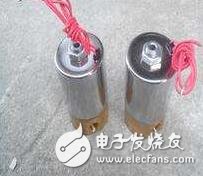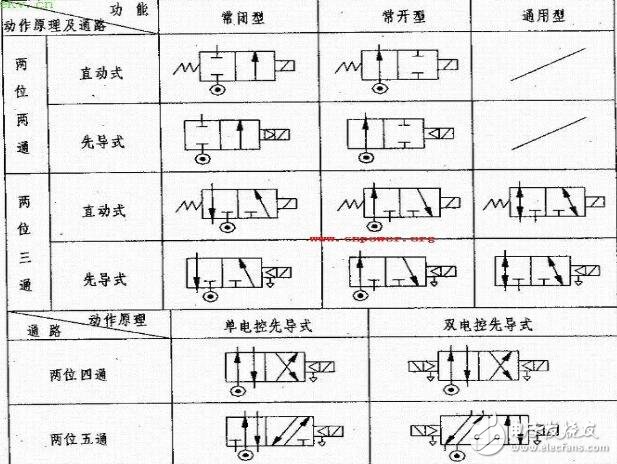The solenoid valve is an electromagnetically controlled industrial device. It is an automatic basic component used to control fluids. It is an actuator, and a pneumatic solenoid valve is one of them. It controls the movement of the valve body to block or leak different oil discharges. The hole, while the oil inlet hole is normally open, the hydraulic oil will enter different oil drain pipes, and then the piston of the oil cylinder is pushed by the pressure of the oil of the pneumatic solenoid valve, so that the current of the electromagnet controlling the pneumatic solenoid valve is controlled. The mechanical movement of the entire solenoid valve.
This article mainly introduces the details of the pneumatic solenoid valve is a few bits and several pairs of solenoid valves. Let's take a look.
Pneumatic solenoid valve is a few bitsPneumatic solenoid valves have many passes and positions depending on function and needs. There are two two-way, two-way three-way, two-way five-way, two-way four-way, solenoid valve. (Two five-way, two four-way and two separate electronic control and dual electronic control).
There are three five-way; three-way five-way: Zhongfeng three-position five-way solenoid valve, medium-pressure three-position five-way solenoid valve, medium-discharge three-position five-way solenoid valve, and three-position four-way solenoid valve. There are also four-position five-way solenoid valves (three electromagnetic heads) for special needs.
Of course, the simplest and most commonly used are two-position three-way solenoid valves and two-position five-way solenoid valves. Use a three-position five-way solenoid valve if the cylinder (actuator) is required to stop in the middle.

The "pass" and "position" are important concepts of pneumatic reversing solenoid valves. Different "on" and "position" constitute different types of pneumatic reversing solenoid valves.
The so-called "two-position valve" and "three-position valve" mean that the spool of the reversing valve has two or three different working positions. The so-called "two-way valve", "three-way valve", "four-way valve" means that two, three, four of the valve bodies of the reversing valve are not connected and can be connected with different oil pipes or gas pipes in the system. Interface, between different oil passages/gas passages can only be communicated through the switch of the valve port when the spool is displaced
In front of the "several digits", you have to look at this valve to have several working states, it can be said that it is a few, if there is a pneumatic component symbol, it is better understood, on the icon represents the square of the valve body (with arrows inside) Or a few T lines) are just a few. The latter "several pass" means that there are several points on one of the squares (the point where the arrow line and the T line intersect), which is a few passes.
The meaning of graphical symbols is generally as follows:
(1) The working position of the valve is indicated by a square, and there are several boxes indicating that there are several "bits";
(2) The arrow in the box indicates that the oil circuit is in the on state, but the direction of the arrow does not necessarily indicate the actual direction of the liquid flow;
(3) The symbol “┻†or “┳†in the box indicates that the passage is unreachable;
(4) If there are several interfaces connected to the outside of the box, it means several "passes";
(5) Generally, the oil inlet/air inlet of the valve and the system oil supply passage or gas connection is indicated by the letter p; the oil return/return port of the valve and the system return oil passage/air passage is t (sometimes o) Indicated; the port/port connected to the valve and the actuator is indicated by a, b, etc. Sometimes used on the graphical symbol to indicate the leaking port;
(6) The reversing valve has two or more working positions, one of which is the normal position, that is, the position where the spool is not subjected to the operating force. The median in the graphical symbol is the normal position of the three-position valve. The two-position valve with spring return is in its normal position with the path state in the box close to the spring. When drawing the system diagram, the oil/gas path should normally be connected to the normal position of the reversing valve.
(The picture below shows three four-way)


On-off, five-way is five channels of ventilation, one of which is connected to the air source, two are connected to the inlet and outlet of the external air chamber of the double-acting cylinder, and two are connected to the inlet and outlet of the internal air chamber, the specific work The principle can refer to the working principle of the double-acting pneumatic actuator: in the gas path (or liquid path), the two-way three-way solenoid valve has one intake hole (connected to the intake air source) and one air outlet (provided to the target) Equipment air source), 1 vent hole (generally installed a muffler, if you are not afraid of noise, you can not install it).
The two-position five-way solenoid valve has one air inlet hole (connected to the intake air source), one positive action air outlet hole and one reverse action air outlet hole (one positive and one reverse action air source respectively supplied to the target device), 1 One positive action vent and one reverse vent (with silencer installed). For small automatic control equipment, the gas pipe is generally 8~12mm industrial rubber pipe. Electrically speaking, the two-position three-way solenoid valve is generally a single electronic control (ie, a single coil), and the two-position five-way solenoid valve is generally a dual electronic control (ie, a double coil). The coil voltage level is generally DC24V, AC220V, etc. The two-way three-way solenoid valve is divided into two types: normally closed type and normally open type. The normally closed type means that the gas path is broken when the coil is not energized, and the normally open type refers to the gas path that is open when the coil is not energized.
The operation principle of the two-way five-way double electronically controlled solenoid valve: when the positive action coil is energized, the positive action air path is turned on (the positive action air outlet has gas), even if the positive action coil is powered off, the positive action air path is still connected. It will be maintained until the counter-action coil is energized. When the reverse action coil is energized, the reverse action air path is turned on (the reverse action air outlet has gas), and even if the reverse action coil is turned off, the reverse action air path is still turned on, and will continue until the positive action coil is energized. . This is equivalent to "self-locking." Based on the characteristics of the two-way five-way dual electronically controlled solenoid valve, when designing the electromechanical control loop or programming the PLC program, the solenoid valve coil can be operated for 1~2 seconds, which can protect the solenoid valve coil from being easily damaged. .
Stainless Steel Sanitary Pipe,Sanitary Pipe Material Stainless Steel Tube,Astm 409 Saintary Stainless Steel Pipe,Ss Seamless Saintary Pipe
ShenZhen Haofa Metal Precision Parts Technology Co., Ltd. , https://www.haofametal.com
